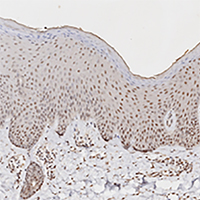MicroRNA-17-3p is upregulated in psoriasis and regulates keratinocyte hyperproliferation and pro-inflammatory cytokine secretion by targeting CTR9

Accepted: 31 December 2021
Supplementary: 99
HTML: 25
All claims expressed in this article are solely those of the authors and do not necessarily represent those of their affiliated organizations, or those of the publisher, the editors and the reviewers. Any product that may be evaluated in this article or claim that may be made by its manufacturer is not guaranteed or endorsed by the publisher.
Authors
Psoriasis is a chronic inflammatory skin disease. Although miRNAs are reported to be associated with the pathogenesis of psoriasis, the contribution of individual microRNAs toward psoriasis remains unclear. The miR-17-92 cluster regulates cell growth and immune functions that are associated with psoriasis. miR-17-3p is a member of miR-17-92 cluster; however, its role in dermatological diseases remains unclear. Our study aims at investigating the effects of miR-17-3p and its potential target gene on keratinocytes proliferation and secretion of pro-inflammatory cytokine and their involvement in psoriasis. Initially, we found that miR-17-3p was upregulated in psoriatic skin lesions, and bioinformatic analyses suggested that CTR9 is likely to be a target gene of miR-17-3p. Quantitative reverse-transcriptase PCR and immunohistochemical analysis revealed that CTR9 expression was downregulated in psoriatic lesions. Using dual-luciferase reporter assays, we identified CTR9 as a direct target of miR-17-3p. Further functional experiments demonstrated that miR-17-3p promoted the proliferation and pro-inflammatory cytokine secretion of keratinocytes, whereas CTR9 exerted the opposite effects. Gain-of-function studies confirmed that CTR9 suppression partially accounted for the effects of miR-17-3p in keratinocytes. Furthermore, Western blot revealed that miR-17-3p activates the downstream STAT3 signaling pathway while CTR9 inactivates the STAT3 signaling pathway. Together, these findings indicate that miR-17-3p regulates keratinocyte proliferation and pro-inflammatory cytokine secretion partially by targeting the CTR9, which inactivates the downstream STAT3 protein, implying that miR-17-3p might be a novel therapeutic target for psoriasis.
How to Cite

This work is licensed under a Creative Commons Attribution-NonCommercial 4.0 International License.
PAGEPress has chosen to apply the Creative Commons Attribution NonCommercial 4.0 International License (CC BY-NC 4.0) to all manuscripts to be published.

 https://doi.org/10.4081/ejh.2022.3275
https://doi.org/10.4081/ejh.2022.3275






